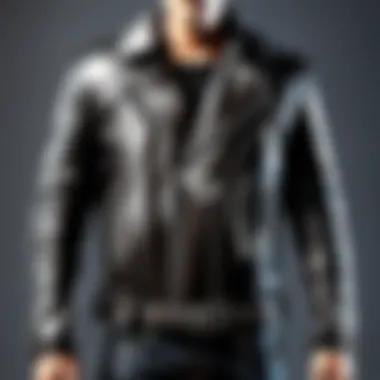Exploring the Leather Biker Outfit: A Detailed Guide


Intro
The leather biker outfit stands as a symbol of rebellion, adventure, and individuality. For many, it represents not just an article of clothing, but a way of life. With roots tracing back to the early 20th century, these outfits were initially designed for functionality and protection. However, over the decades, the aesthetic and cultural implications have evolved significantly.
This guide explores the various dimensions of the leather biker outfit, from its historical significance to practical aspects of how to choose the right attire. Whether you are an avid motorcyclist or a fashion enthusiast drawn to its strong visual identity, understanding this outfit is essential. Let us embark on this comprehensive inquiry into leather biker outfits.
Historical Significance
Delving into the historical facets, the leather biker jacket gained prominence during the late 1920s. Initially utilized by motorcyclists, it has become ingrained in popular culture, often romantically associated with the rebellious spirit of the era. Actors like Marlon Brando and James Dean popularized the leather outfit in films, which solidified its status in pop culture.
Moreover, in military contexts, leather was historically favored for its durability and protective qualities. That tradition trickled down to civilian life, especially among the motorcycle clubs that flourished post-World War II. Those clubs fostered not just camaraderie but a distinctive style that has persisted to this day.
Contemporary Variations
As society evolved, so did the designs of leather biker outfits. Nowadays, one can find a plethora of styles and variations catering to diverse tastes. From classic, form-fitted cuts to more relaxed, fashion-forward silhouettes, choices abound. Common features often include:
- Zippered fronts
- Decorative hardware
- Padded shoulders
Moreover, various colors have emerged beyond the traditional black. Browns, grays, and even vivid hues offer options for personalization. The embrace of sustainable leather practices has influenced modern designs as well. Brands increasingly opt for ethically sourced materials, appealing to conscious consumers.
Practical Considerations for Wear
When considering a leather biker outfit, practical characteristics are as important as aesthetic ones. The fit should be conducive for riding while retaining an element of style. Consider these factors:
- Material Quality: Authentic leather ensures durability.
- Protective Features: Look for armor pockets or reinforced sections for extra safety.
- Weather Resistance: Opt for treated leather if riding in variable climates.
These aspects are crucial for effective use during rides and various environments.
Prelude to Leather Biker Outfits
Leather biker outfits hold a significant place in the world of fashion and functionality. These outfits are not merely a choice for members of motorcycle culture; they represent history, individuality, and a desire for freedom. To appreciate their full meaning, it is crucial to explore what leather biker attire is, its evolution, and how it has adapted through the years.
Definition and Overview
A leather biker outfit typically includes a jacket, pants, and appropriate footwear, crafted from various types of leather. Each piece serves a specific role, merging style with practical needs of riders. The dark, durable materials often signify rebellion and toughness, reflecting a certain lifestyle that many admire. The aesthetic query is about more than just riding machinery; it embodies an ethos of adventures, craftsmanship, and identity.
These outfits have become symbols, not simply due to their function but also because of a culture deeply ingrained in the wearer. They speak volumes about the personalities of individuals who choose such attire.
Historical Context
The roots of leather biker outfits trace back to the early 20th century, closely associated with both military and protective garments. Early motorcyclists needed durable clothing designed to withstand the road’s harshness. The leather material became favored for its resilience against wear and weather.
After World War II, motorcycles surged in popularity. Media representations solidified the association between leather and freedom, greatly influenced by films of the era. These films often portrayed the riders as rebellious characters, which enhanced the allure of leather biker outfits. Icons like Marlon Brando and James Dean further fuelled this perception, cementing leather jackets and biker gear into mainstream culture.
Today, the leather biker outfit transcends mere functionality. It has been adopted into fashion revolutions and continued to evolve. Notably, high-end designers also embrace these classic styles, merging modernity with tradition. This remarkable journey highlights the significance of leather clothing, both on and off the motorcycle.
Materials Used in Leather Biker Outfits
Materials form the backbone of leather biker outfits, determining both their style and functionality. Quality and type of materials influence everything from durability to comfort. In this section, we will investigate various leather types and their synthetic counterparts. This is crucial for anyone aspiring to choose the right attire in the realm of biking.
Types of Leather
Full Grain
Full grain leather is the apex of leather choices due to its preservation of the natural grain and texture. This type emphasizes authenticity, as no surface alterations are applied. Its strength is unmatched, making it exceptionally resistant to wear and tear. The natural imperfections make each piece unique.
Its durability translates to a long-lasting bikers outift. Full grain leather becomes softer over time, providing a character and style that can not be replicated by lower grade materials. For riders who prioritize both style and practicality, it is a wise investment.
Advantages of Full Grain:
- High durability
- Aged appeal that improves over time
- Breathable, enhancing comfort during rides
Disadvantages:
- Typically more expensive
- Requires regular maintenance to prevent drying out
Top Grain


Top grain leather is similar to full grain but under goes a process to remove defects, resulting in a refined surface. This smooth characteristic appeals to those looking for sleek aesthetics. The overall finish creates a classy look, suitable for various keep fit riding styles.
Although it is not as durable as full grain, it offers better resistance against stains and spills. This makes it advantageous for daily use. Riders may appreciate its structured feel without compromising too much on comfort.
Advantages of Top Grain:
- Smoother, more uniform appearance
- Better stain resistance
- More cost-effective than full grain
Disadvantages:
- Less durable compared to full grain
- May lack breathability compared to full-grain options
Bonded Leather
Bonded leather, made from leather scraps held together with adhesives, represents a budget-friendly method for achieving a leather-like look. While it lacks the premium quality and feel of full or top grain, it's a practical choice for those on a budget. Its use in cycling gear aims to bring aesthetics within reach.
However, bonded leather has lower durability and is less breathable, making it an inferior choice for serious riders. Although this material might appeal to casual users, it falls short for anyone needing the outfit’s integrity over time.
Advantages of Bonded Leather:
- Affordable and readily available
- Environmentally friendly in some production processes
Disadvantages:
- Lacks durability compared to natural leather
- May not provide the protection necessary for serious biking activities
Synthetic Alternatives
The rise of synthetic materials has opened new pathways for leather attire. These materials aim to replicate leather characteristics while offering practical benefits to users. Such materials might provide certain advantages such as lighter weight or resistance against elements.
However, any consideration of synthetic options demands attention to specific needs, such as breathability and authentisity. Such synthetic models emerge frequently, necessitating diligence in selection.
By choosing the right material, a biker not only invests in their comfort and safety but also boosts their overall riding experience.
The Anatomy of a Leather Biker Outfit
Understanding the anatomy of a leather biker outfit is critical for both the practical rider and the fashion-conscious individual. The main elements of this outfit serve functional and aesthetic purposes, highlighting the importance of choosing the right components. Whether one wears leather for protection or style, each part contributes distinctly to the overall appeal and effectiveness of the attire.
Jackets
Styles
When discussing styles of jackets in leather biker outfits, one cannot underestimate their significance. Distinct style choices, such as classic cruiser jackets and modern bomber jackets, offer variation to meet both personal taste and riding needs. Each style serves to not only represent the persona of the rider but also maintains related functionalities, like allowing for easy movement in the saddle.
A benefit of different styles is versatility; they can be worn both on and off the bike without losing visual impact. Additionally, classic styles often have a time-tested reputation for comfort and durability. However, opting for unique or modern designs may lead to compromised protective features in certain models.
Fit and Comfort
Fit and comfort directly impact how a rider experiences their journey. A properly fitted leather jacket ensures that the garment will stay in place during rides. Many brands produce jackets with different fits, such as slim fit or relaxed fit, catering to varying body types and preferences. Riders should be cautious about choosing overly snug or loose jackets, which can lead to discomfort or reduced safety if they cannot secure well.
The ideal jacket should also allow for ample air circulation and an ease of movement. Removable linings are common in many contemporary leather jackets, enhancing adaptation to weather changes. Still, keeping a jacket that strikes a balance between snugness and maneuverability should be a priority for anyone seeking a well-rounded wearing experience.
Pants
Fit Types
Footing your outfit with the right pair of pants completes your overall look in every sensible manner. With various fit types such as slim, regular, and relaxed, finding a matching style allows riders to coalesce safety, comfort, and Higgins out of their ride. Riders may prefer tighter fits for snugness but they should consider mobility or else choose loose iterations for those leisurely day events without tightness.
Fit type also influences safety during rides. For example, a relaxed fit can prevent tightness while adhering prevents the garment from twisting on prolonged rides, while tighter pant styles may reduce airflow. Understanding fit types creates opportunity for testing which demands best meets personal requirements for rides.
Protection Features
When the heat of the road hits, one must always consider protection features in clothes, especially pants. Features that provide additional defense against abrasions and impact include padded knee panels and heavy-duty stitching. Often, motorcycle pants utilize tougher materials as compared to standard jeans.
Just investing in purchasing is never enough; checking out CE-certified protection features will yield more benefit in the long run. For technical riding, garments that incorporate armor in knee compartments offer preemptive safety each time. Conversely, casual pants might provide style, but those don’t emphasize protective elements that are required on rough roads or trails.
Footwear


Boot Types
The footwear segment in a leather biker outfit cannot be understated. Boot types range vastly from classic engineer types to modern riding boots, aimed at providing support while ensuring safe riding falls within best practices. The material stores typically adapted for heavy-duty wear helps align footwear choices. Quality should outbalance design to prolong the wear of the rider's boots.
Each boot type plays a role in comfort and function. For example, engineer boots provide ease of wear and straightforward styling yet might not safeguard clarifying protections. Conversely, some specialized riding boots may come equipped with reinforced shanks but directly normalize warmth and moisture.
Functionality vs.
Style
Functionality versus style is a recurring debate among riders. While striking visual appeal is tempting, practicality in design should weigh equally, if not more, in choice decisions. Vibrant designs can woo audiences considerably, showcasing a rider’s personality. However, fundamental concerns around safety should dictate which features ultimately hold precedence, such as armor plating versus trending stiletto heels.
Understanding where utility intersects with style aids in the personal clothing realm. Combining elements can maximize enjoyment on the bike to relatable environments. Garantour, as in most choices, long-term investors yield valued wear offs much over short-run aesthetics that compromise rider experiences.
“A motorcycle journey is not merely about the bike; it’s about the outfit that supports each mile.”
Styling a Leather Biker Outfit
Styling a leather biker outfit goes beyond mere appearance; it encapsulates personality, functionality, and cultural identity. Each element in this attire plays a key role in portraying the essence of biking culture. Understanding how to stylishly combine various pieces helps riders express individuality while ensuring comfort and protection.
Layering Techniques
Layering is crucial, especially since bikers face varying weather conditions. An effective system of layers allows flexibility and comfort. Start with a good base layer. This layer maintains body temperature and supports moisture-wicking.
Mid-layers, like thermal shirts or fleece, provide added warmth without bulk. The top layer usually consists of a leather jacket, offering protection against wind and abrasions. To layer effectively:
- Choose the Right Materials: Lightweight and breathable fabrics enhance comfort while providing insulation.
- Fit Matters: Ensure each layer fits well without restricting movement.
- Weather Adaptability: Incorporate removable layers for changing weather.
Accessorizing
Accessorizing enhances both function and fashion in a leather biker outfit. Thoughtful choices in accessories can bridge the gap between style and utility.
Belts
A belt is not just a functional necessity; it represents a statement of style in leather biker attire. A well-chosen belt adds structure to an outfit.
- Key Characteristic: Leather belts stand out for their durability.
- Why Choose Leather: It coordinates well with the overall rugged appeal of biker outfits.
- Advantages: Leathers belts not only enhance aesthetics but also last long and require minimal maintenance.
However, be cautious of widths; wider belts can clash with tighter riding pants.
Gloves and Helmets
Gloves and helmets are essential safety gear that complements a leather biker outfit. These pieces must merge protection and design effectively.
- Key Characteristic: Gloves made of leather offer both grip and comfort.
- Why Choose Them: They shield hands from elements and abrasions.
- Unique Features: Features such as touch-screen compatibility on gloves help maintain functionality, while full-face helmets provide maximum protection.
Each accessory may have a significant impact on safety and performance, comforting bikers to take on the roads confidently.
Aesthetic Variations
Style is not just about functionality; it speaks to the broader aesthetic choices of a biker. Variations in aesthetics can redefine one's presence on a bike. Riders may lean towards timeless classical looks or modern interpretations.
Classic vs.
Modern Looks
The choice between classic and modern biker fashion speaks volumes about one's personality. Classic looks honor a history imbued with a sense of nostalgia. The use of traditional pieces like black leather jackets often allies with silver hardware. In comparison, modern looks can include brighter colors and varied materials.
- Benefits of Classic Style: It portrays a sense of commitment to biker culture.
- Advantages of Modern Style: The modern aesthetic provides versatility and appeals to a broader demographic, bringing fresh ideas to traditional frameworks.
Color Choices
Colors play a vital role in personal expression in biker outfits. Traditionally, black is the dominant color due to its association with classic biker culture. However, this landscape is broadening. Bold reds, deep blues, or earth tones invite individuality.
- Key Characteristic: Colors influence emotional responses.
- Why It Matters: Certain colors may represent specific cultural movements within the biking community.
- Unique Feature: A vivid choice can signify rebellion, while muted shades often suggest underplaying one’s role.
Ultimately, color choice allows riders to showcase their unique aesthetics while reflecting their personal styles.


Practical Considerations for Leather Biker Outfits
Practical considerations play a crucial role when it comes to leather biker outfits. These garments are not only a fashion statement but also serve specific functions that enhance the riding experience. The key elements here include comfort, mobility, and weather resistance. While aesthetics are important, knowing how these practical factors affect an outfit can ensure a better and safer riding journey. Understanding these elements becomes essential for anyone looking into investing in leather biker attire.
Comfort and Mobility
When selecting a leather biker outfit, comfort should be a primary consideration. Riders often spend long periods on their bikes, making discomfort an unwelcomed issue. Proper fit is vital; an outfit that is too tight can limit mobility, leading to discomfort during rides. Biker jackets, for instance, must allow for adequate arm movement while handling the motorcycle.
Moreover, factors like body type and riding position will dictate the type of fit that works best. It is advisable to try on various styles, focusing on flexibility and ease of movement. Always check for the range of motion in arm lifts and bends. Opt for jackets with features like stretch panels, which can aid in posture and maneuverability.
Key factors to consider for comfort include:
- Leather Thickness: Thicker leather offers more protection but can restrict movement.
- Lining Material: A soft inner lining will improve comfort levels, reducing irritation from ride friction.
- Weight of the Garment: Heavy garments can become uncomfortable on long rides; consider lighter options for extended travel.
Weather Resistance
Weather resistance is an pivotal aspect when selecting a leather biker outfit. Riders frequently face diverse weather conditions, making it critical that their gear offers a good barrier against the elements. Quality leather naturally provides a degree of water resistance, but additional treatments can further enhance this quality, promoting durability during inclement weather.
Investing in a jacket that features a removable waterproof liner can bolster protection for rainy days. Windproof materials are also advantageous for high-speed rides. It is essential to consider good fit again, as excess space can allow wind and water to enter the outfit, negating its protective properties.
Riders may want to consider the following:
- Water Resistance Treatments: Fabrics that are treated for rain protection.
- Ventilation: Features for airflow to manage temperature in warmer climates.
- Number of Layers: Adjustable layers can provide warmth in colder conditions, while easily removable lining can keep the garment lightweight.
In summary, the leather biker outfit's practical considerations will elevate not only comfort and protection but also enhance the overall riding experience.
Taking the time to evaluate comfort and weather resistance ensures that your investment in a leather biker outfit will serve you well for years, providing both style and the kind of functionality that enhances every ride.
Maintenance of Leather Biker Outfits
Maintaining leather biker outfits is crucial for both aesthetic appeal and enhanced longevity. With a sturdy material like leather, specific care strategies ensure that the outfit not only survives the rigors of riding but also continues to look its best. Good maintenance preserves the texture, prevent damage from elements, and enables the biker to focus on enjoyment and experience. Moreover, regular upkeep can delay costly replacements.
Cleaning Techniques
Cleaning leather biker outfits requires a mindful approach. Improper cleaning can lead to irreversible damage, so understanding the correct methods is essential. Here are several techniques to effectively clean your leather gear:
- Use a damp cloth: Begin any cleaning process with a soft, damp cloth. This removes dust and light dirt. It is essential to avoid soaking the leather.
- Mild soap solution: For tougher stains, mix warm water with a mild soap like glycerin soap. Apply this solution lightly with a cloth. Avoid scrubbing hard as that can scratch the surface.
- Avoid harsh chemicals: Stay away from bleach or other strong chemicals. These substances can strip natural oils from the leather, causing it to crack or fade. Stick to products specifically designed for leather.
Keep in mind, cleaning leather should be done judiciously. Too frequent cleaning can wear out the leather more quickly than exposure to dirt or grime.
Conditioning Leather
Conditioning is a crucial step to maintain the leather's suppleness and prevent cracking. Leather can dry out over time, losing its natural oils. Here are key points on leather conditioning:
- Choose the right conditioner: Select a high-quality leather conditioner. Products like Biconti leather conditioner or Leather Honey work well.
- Apply evenly: Using a soft cloth, apply the conditioner in smooth, circular motions. Take your time to ensure full coverage.
- Let it absorb: After application, let the conditioner soak in for at least 30 minutes. This step enriches the leather, giving it a refreshed look while enhancing its durability.
- Frequency of conditioning: A general rule is to condition the leather every three to six months, depending on usage and climatic conditions. More frequent use may warrant more regular care.
Remember that conditioned leather can resist water, preventing elements from causing damage or discoloration.
Storage Best Practices
Storing leather biker outfits appropriately is just as essential as cleaning and conditioning. Proper storage can prevent deformities caused by improper hanging or weight:
- Cool, dry place: Always store leather in a cool, dry area. Avoid extreme heat or humidity, which can affect the leather quality negatively.
- Hanging vs folding: Hanging is preferable for jackets and pants. Use padded hangers to maintain the shape. For boots, maintain their shape with boot trees.
- Dust covers: Using breathable garment bags reduces dust accumulation without suffocating the material. Avoid plastic as this traps moisture.
Quoted from a biker care guide: “Foil structures must always remain sheltered from the non-breathable airflow caused by wet environments or too much warmth—this most common distresses along the emotional resonances of compatible leather by occasion!”
In summary, thoughtful cleaning, conditioning, and storing your leather biker outfits fosters a deeper connection with the gear while ensuring it stands the test of time. An integral part of the leather biker experience is maintaining that experience with appropriate care.
Finale
In this article, the exploration of leather biker outfits showcases not only their practical applications but also their rich narrative in fashion history. Understanding the characteristics and implications of a leather biker outfit is critical for both enthusiasts and practical riders alike.
Recap of Key Points
The discussions on this comprehensive guide focused on several key areas:
- The historical significance of leather biker outfits, starting from their origins to their evolution in modern fashion.
- Different materials used in these outfits, like various types of leather and even synthetic alternatives, which impact durability and comfort.
- The anatomy of the outfit itself, specifically jackets, pants, and footwear, emphasizing functionality alongside style.
- Styling considerations including the role of layering, accessories, and trends between classic and contemporary looks.
- Practical matters for wear including comfort, mobility, and weather resistance.
- Essential maintenance tactics ensuring longevity of leather attire through proper cleaning and conditioning techniques.
Final Thoughts on Leather Biker Attire
Leather biker attire remains an enduring symbol of adventure and a critical component in modern motorcycling. It reflects a blend of personal style, ride safety, and comfort. For those who participate in the biker lifestyle, understanding the intrinsic qualities and varieties of leather outfits can enhance their riding experience.
Equipped with knowledge from historical context to practical maintenance, riders can make informed choices that not only adhere to safety but also project individuality. Biker culture is inclusive yet defined; your leather outfit can speak volumes about your approach to motorcycling, both on the road and off. Thus, investing in quality attire should be a priority for both commuters and leisure riders alike. To delve deeper into community discussions surrounding biker fashion, consider visiting platforms such as Reddit or Facebook communities dedicated to motorcycle enthusiasts and fashion.



